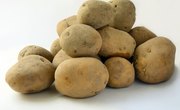
Electricity is a key part of the science curriculum. Projects allow students to experiment with an idea themselves, and become comfortable with the concepts behind the subject. Different school electricity projects will allow students to experiment in different areas. Depending on your resources, and the particular area you are teaching, you can select a project which is rewarding.
Vegetable Power
Use a fruit or vegetable to power a small bulb to show the electric potential of different objects. Place a copper electrode and a zinc electrode in a potato, and attach the electrodes to a small bulb with alligator clips. The bulb will light up. Try this with other fruits and vegetables, and see how this affects the bulb. The best conductors of electricity will be those that have a high water content, such as cucumber, lemon or orange. Move the electrodes inside the fruit to see what impact this has on the bulb, and therefore the electricity. The closer the electrodes are, the greater the flow of electricity will be.
Temperature
Test the impact of temperature on electricity by cooling batteries to different temperatures and seeing how this affects performance. Place one battery in a freezer, one in a refrigerator, one in cold water, one at room temperature, and one in direct sunlight. Test each of these and see how it impacts performance. This will give you an insight into the optimum way that electrons move, and the optimum way to store batteries within the home. Batteries work best when stored at cold temperatures, and this will be the conclusion that the students will reach. The colder the temperature, the longer the battery will last.
Magnetism and Electricity
Investigate the link between electricity and magnetism. Set up a small circuit using batteries, a small bulb and some alligator clips. Test a variety of objects to see if they are magnetic, by holding them against a magnet. Once you have determined if they are magnetic, add them to the electric circuit by attaching alligator clips each side. You will be able to make a conclusion as to the correlation between magnetism and electricity. Items which are magnetic are also able to conduct electricity, owing to both magnetism and conducting being intrinsically linked.
Good Conductors
Test different objects to see if they are good conductors of electricity. Make a small circuit, containing batteries and a small bulb. Place alligator clips between the two, and attach different objects to see what is a good conductor. Try a range of objects, including different types of soils, coins and various household objects. This will allow you to make conclusions on what is a good conductor. Decide what good conductors have in common, and why you think this is the case. The best conductors will be copper and silver, and the worst will be items such as wood.
References
About the Author
Emile Heskey has been a professional writer since 2008, when he began writing for "The Journal" student newspaper. He holds a Bachelor of Arts in modern history and politics from Oxford University, as well as a Master of Science in Islamic and Middle Eastern studies from Edinburgh University.
Photo Credits
Jupiterimages/BananaStock/Getty Images
